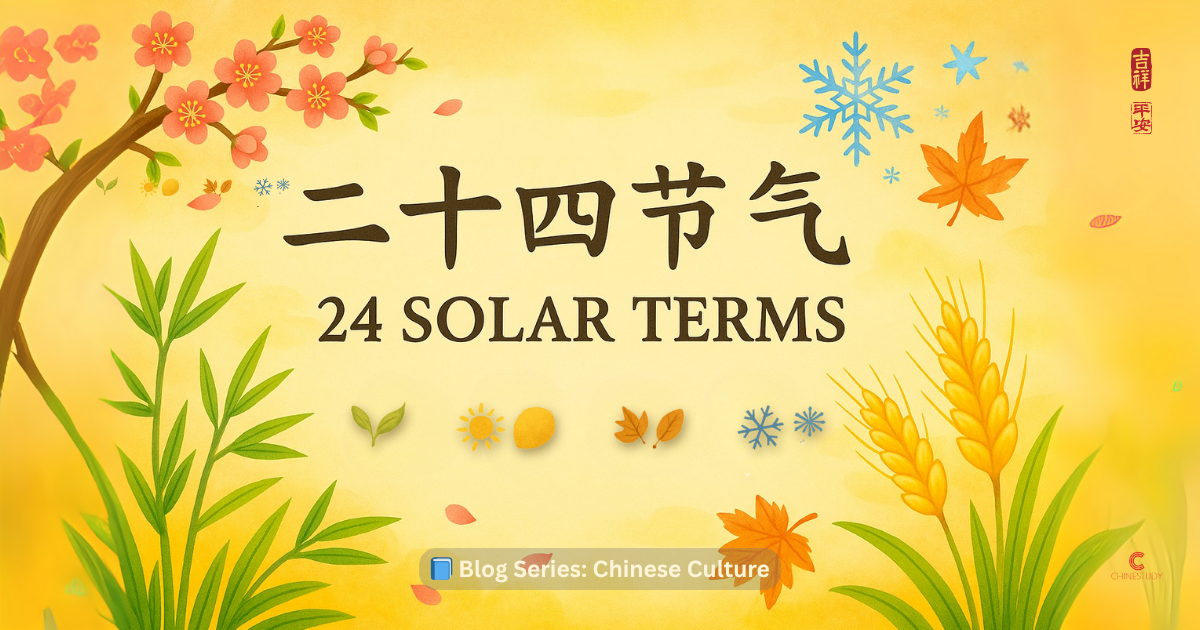🌿 二十四节气 – The 24 Solar Terms in Chinese Culture

🌞 What Are the Solar Terms?
The 24 solar terms (二十四节气) are part of the traditional Chinese calendar. They divide the year into 24 parts, based on the sun’s position in the sky.
They reflect:
- Seasonal changes
- Climate patterns
- Natural rhythms in farming and daily life
Each term lasts about 15 days and marks shifts like:
- Start of spring (立春 Lìchūn)
- Grain ripening (芒种 Mángzhòng)
- Coldest days (大寒 Dàhán)
- Longest night (冬至 Dōngzhì)
🌏 Why Are They Important?
Before modern technology, people used the solar terms to:
- Plant and harvest crops at the right time
- Balance their food and health with the season
- Celebrate special seasonal traditions
Even today, the solar terms guide festivals, eating habits, and daily wellness in many parts of China.
🧭 A Year of Nature’s Rhythm
Here are the 24 solar terms, grouped by season:
🍃 Spring
1. 立春 (Lìchūn) – Start of Spring
2. 雨水 (Yǔshuǐ) – Rain Water
3. 惊蛰 (Jīngzhé) – Awakening of Insects
4. 春分 (Chūnfēn) – Spring Equinox
5. 清明 (Qīngmíng) – Clear and Bright
6. 谷雨 (Gǔyǔ) – Grain Rain
☀️ Summer
7. 立夏 (Lìxià) – Start of Summer
8. 小满 (Xiǎomǎn) – Grain Fills
9. 芒种 (Mángzhòng) – Grain in Ear
10. 夏至 (Xiàzhì) – Summer Solstice
🍂 Autumn
13. 立秋 (Lìqiū) – Start of Autumn
14. 处暑 (Chǔshǔ) – Limit of Heat
15. 白露 (Báilù) – White Dew
16. 秋分 (Qiūfēn) – Autumn Equinox
17. 寒露 (Hánlù) – Cold Dew
18. 霜降 (Shuāngjiàng) – Frost Descent
❄️ Winter
19. 立冬 (Lìdōng) – Start of Winter
20. 小雪 (Xiǎoxuě) – Minor Snow
21. 大雪 (Dàxuě) – Major Snow
22. 冬至 (Dōngzhì) – Winter Solstice
23. 小寒 (Xiǎohán) – Minor Cold
24. 大寒 (Dàhán) – Major Cold
🗣️ Key Vocabulary & Expressions
- 节气 (jiéqì) – Solar term
- 顺应天时 (shùnyìng tiānshí) – Follow nature’s timing
- 农历 (nónglì) – Lunar calendar
- 节奏 (jiézòu) – Rhythm
- 物候 (wùhòu) – Natural seasonal signs
📚 Try This!
Translate and read aloud:
我们应该顺应节气的节奏。
(Wǒmen yīnggāi shùnyìng jiéqì de jiézòu.)
→ We should follow the rhythm of the solar terms.
🇨🇳 Cultural Insight
The solar terms are not just about weather.
They teach us to:
- Observe nature
- Adjust our habits
- Respect timing — know when to act, and when to rest
In Chinese culture, living in harmony with the seasons is a key to both health and wisdom.
🌟 Final Thoughts
Whether you’re planting rice 🌾 or sipping tea 🍵, the solar terms remind us that everything has its time.
By following these ancient markers, we don’t just watch the seasons — we move with them.
🌿☀️ Notice the rhythm — and let nature be your guide.
🇨🇳 Curious about more Chinese traditions?
📚 Step into the blog series: Chinese Culture!
Thank you for subscribing!
Have a great day!